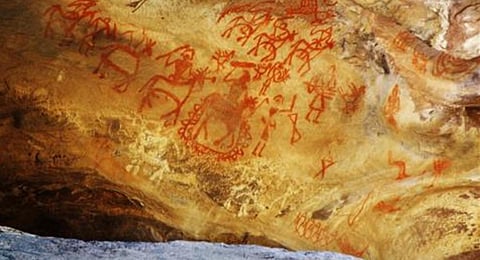

KADAPA: Historians expressed joy after the Centre’s announcement to declare the rock shelters consisting of rock paintings in Chintakunta area in Muddanur mandal of Kadapa district a national heritage site.
On April 3, Union Minister for Tourism G Kishan Reddy, replying to a question posed by Machilipatnam MP Vallabhaneni Balashowry in the Lok Sabha, said the Centre has identified the Chintakunta rock shelters consisting of rare paintings belonging to Mesolithic to Megalithic era to declare as a protected site. Following the due procedure, the Centre will declare the Chintakunta rock shelters a national heritage site, which houses India’s second-largest rock paintings.
Over the years, historians and archilovers under the aegis of the Indian National Trust for Art and Cultural Heritage (INTACH), have been demanding that Chintakunta rock shelters be preserved and protected by declaring the area a national heritage site.
INTACH AP and Telangana convenor Gopal Krishna urged the then AP Archaeology Department convenor Vani Mohan to protect the site. Based on the commissioner’s order, Gopal Krishna and INTACH member Mogili Chendu Suresh submitted an assessment report to the government on December 18, 2019, after inspecting Chintakunta mountains.
In all, 200 rock art paintings were found, excluding the faintly/partly visible drawings with pigment patches. They include figures of deer, humped bulls, elephants, foxes, rabbits, hyenas, reptiles and birds. Anthropomorphic, geometric designs and human figures and 10 of them are in white.
Some red paintings depicting elephants, elephant riders and religious symbols go well in stylistic and thematic patterns with that of white paintings. The human figures are holding bows and arrows, facing each other and riding elephants.
The humped bulls are seen in one rock shelter locally known as ‘ Eddula Avula Gundu’ and may be dated contemporaneously with the humped bulls of Neolithic Art of Southern Neolithic culture.